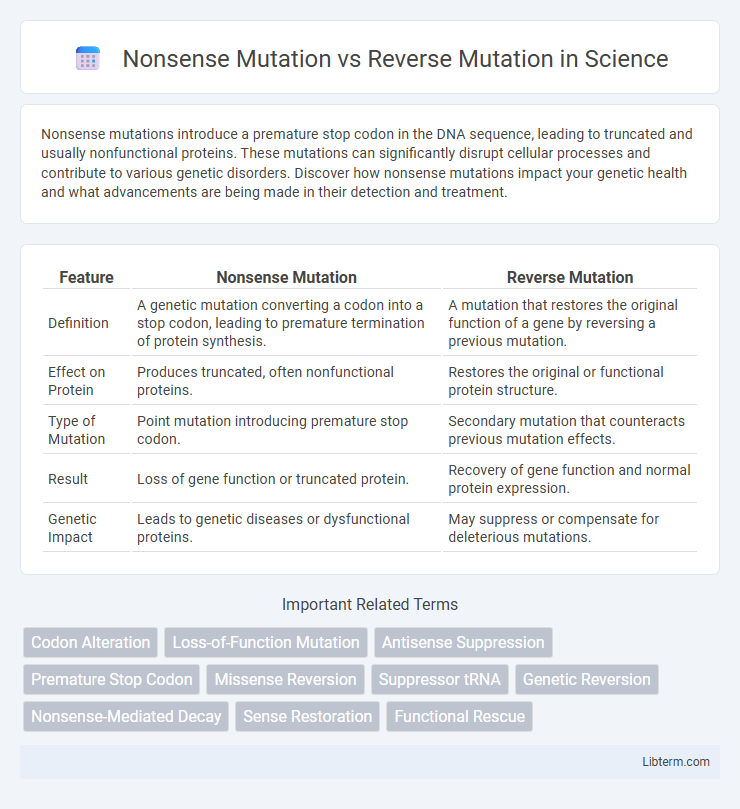Nonsense mutations introduce a premature stop codon in the DNA sequence, leading to truncated and usually nonfunctional proteins. These mutations can significantly disrupt cellular processes and contribute to various genetic disorders. Discover how nonsense mutations impact your genetic health and what advancements are being made in their detection and treatment.
Table of Comparison
| Feature | Nonsense Mutation | Reverse Mutation |
|---|---|---|
| Definition | A genetic mutation converting a codon into a stop codon, leading to premature termination of protein synthesis. | A mutation that restores the original function of a gene by reversing a previous mutation. |
| Effect on Protein | Produces truncated, often nonfunctional proteins. | Restores the original or functional protein structure. |
| Type of Mutation | Point mutation introducing premature stop codon. | Secondary mutation that counteracts previous mutation effects. |
| Result | Loss of gene function or truncated protein. | Recovery of gene function and normal protein expression. |
| Genetic Impact | Leads to genetic diseases or dysfunctional proteins. | May suppress or compensate for deleterious mutations. |
Introduction to Nonsense and Reverse Mutations
Nonsense mutations introduce a premature stop codon in the DNA sequence, leading to truncated and typically nonfunctional proteins, disrupting normal cellular processes. Reverse mutations, or back mutations, restore the original nucleotide sequence or protein function by correcting the previous mutation, enabling the gene to regain its initial biological activity. Understanding these mutation types is crucial for genetic research, as they impact gene expression, protein synthesis, and hereditary disease mechanisms.
Defining Nonsense Mutation
Nonsense mutation is a genetic alteration where a codon is changed into a premature stop codon, leading to the truncation of the resulting protein. This mutation disrupts normal protein synthesis and often results in loss of function or nonfunctional proteins. Reverse mutation, in contrast, restores the original wild-type sequence, potentially recovering the protein's normal structure and function.
Defining Reverse Mutation
Reverse mutation, also known as a back mutation, restores the original wild-type sequence by correcting a previous mutation, often reversing the effects of a nonsense mutation that introduces a premature stop codon. Nonsense mutations result in truncated proteins due to a codon change that converts an amino acid codon into a stop codon, disrupting normal protein synthesis. The process of reverse mutation enables the production of functional proteins by repairing these faulty codons and reinstating proper gene expression.
Molecular Mechanisms Behind Nonsense Mutations
Nonsense mutations occur when a premature stop codon is introduced into the DNA sequence, leading to truncated, nonfunctional proteins due to early termination during translation. This process involves a change in a single nucleotide that converts an amino acid codon into one of the three stop codons (UAA, UAG, UGA), disrupting normal protein synthesis. Reverse mutations, or back mutations, restore the original functional sequence by correcting or compensating for the initial mutation, allowing the production of full-length, functional proteins.
How Reverse Mutations Occur
Reverse mutations occur when a second mutation restores the original nucleotide sequence or function disrupted by a nonsense mutation, either by a true back mutation that directly reverts the stop codon to the original codon or by a suppressor mutation that bypasses the premature stop signal. These processes enable the production of functional proteins by correcting or compensating for the initial codon alteration causing early translation termination. Reverse mutations are crucial for understanding genetic variability and can influence the phenotypic reversal of inherited disorders caused by nonsense mutations.
Biological Consequences of Nonsense Mutations
Nonsense mutations introduce premature stop codons, leading to truncated, nonfunctional proteins that often disrupt normal cellular processes and result in diseases such as cystic fibrosis and Duchenne muscular dystrophy. Reverse mutations, or back mutations, restore the original amino acid sequence by correcting the nonsense mutation, thereby reestablishing proper protein function. The biological consequences of nonsense mutations include loss of protein function, activation of nonsense-mediated decay pathways, and phenotypic abnormalities due to incomplete gene expression.
Functional Restoration by Reverse Mutation
Nonsense mutations introduce premature stop codons, resulting in truncated, nonfunctional proteins that disrupt normal cellular processes. Reverse mutations, also known as suppressor mutations, restore protein function by either correcting the original nonsense mutation or compensating for its effects, enabling translation to proceed and full-length proteins to form. This functional restoration is crucial for alleviating genetic disorders caused by nonsense mutations, as it reinstates the proper biological activity of essential proteins.
Detection Methods for Nonsense and Reverse Mutations
Detection methods for nonsense mutations primarily rely on techniques such as DNA sequencing and allele-specific PCR to identify premature stop codons within gene sequences. In reverse mutation analysis, screening approaches like revertant colony isolation combined with sequencing confirm restoration of the wild-type sequence or function. Advanced methods including high-throughput next-generation sequencing enhance accuracy in detecting both nonsense and reverse mutations by providing detailed genetic insights.
Clinical Implications of Nonsense vs Reverse Mutations
Nonsense mutations introduce premature stop codons, often resulting in truncated, nonfunctional proteins that can lead to severe genetic disorders such as cystic fibrosis or Duchenne muscular dystrophy. Reverse mutations, also known as suppressor or reversion mutations, restore the original amino acid sequence or function, potentially rescuing protein activity and mitigating disease severity. Clinically, understanding the occurrence and frequency of reverse mutations is crucial for developing targeted therapies like read-through drugs that aim to bypass premature stop codons in nonsense mutation-driven diseases.
Key Differences Between Nonsense and Reverse Mutations
Nonsense mutations introduce premature stop codons into the DNA sequence, leading to truncated, nonfunctional proteins, whereas reverse mutations restore the original nucleotide sequence, rescuing normal protein function. Nonsense mutations often result in loss-of-function phenotypes, while reverse mutations revert mutant alleles back to wild-type, reversing the phenotypic effects. The key difference lies in their impact on protein synthesis: nonsense mutations halt translation prematurely, whereas reverse mutations enable full-length protein production.
Nonsense Mutation Infographic

 libterm.com
libterm.com